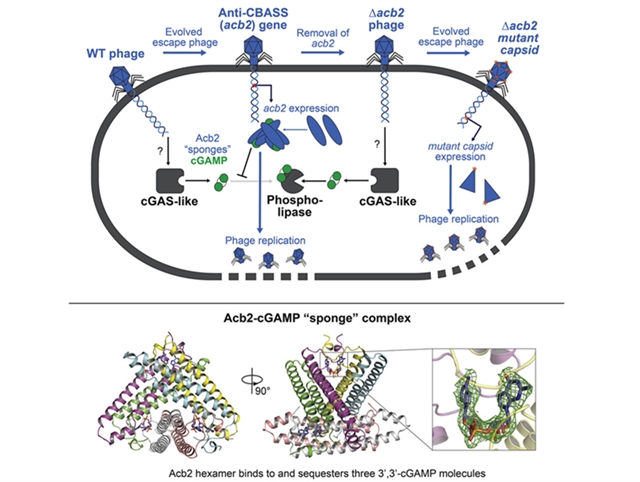噬菌体抑制和逃避细菌的类cGAS免疫功能

美国加州大学旧金山分校Joseph Bondy-Denomy等研究人员合作发现,噬菌体抑制和逃避细菌的类cGAS免疫功能。相关论文于2023年2月6日发表在《细胞》杂志上。
研究人员在铜绿假单胞菌中发现了一种内源性类cGAS酶,在噬菌体感染期间产生3′,3′-cGAMP,向磷脂酶效应物发出信号,并限制噬菌体复制。作为回应,噬菌体表达一种抗CBASS蛋白(“Acb2”),该蛋白与三个3′,3′-cGAMP分子形成六聚体,并降低磷脂酶活性。Acb2还与其他细菌类cGAS酶(3',3'-cUU/UA/UG/AA)和哺乳动物cGAS(2′,3′-cGAMP)产生的分子结合,表明对基于cGAS的免疫有广泛的抑制作用。Acb2缺失后,CBASS会阻断噬菌体的复制和溶原诱导,但罕见的噬菌体会通过主要的衣壳基因突变逃避CBASS。总之,研究人员证明了内源性CBASS的抗噬菌体功能以及CBASS抑制和逃避的策略。
据介绍,真核生物抗病毒免疫的一个基本策略涉及cGAS酶,它合成2′,3′-cGAMP并激活效应子STING。不同的细菌含有类cGAS酶,产生环状寡核苷酸并诱导抗噬菌体活性,称为CBASS。然而,这种活性仅通过异源表达得到证实。携带CBASS的细菌是否与噬菌体拮抗并共同演化尚不清楚。
附:英文原文
Title: Bacteriophages inhibit and evade cGAS-like immune function in bacteria
Author: Erin Huiting, Xueli Cao, Jie Ren, Januka S. Athukoralage, Zhaorong Luo, Sukrit Silas, Na An, Hélose Carion, Yu Zhou, James S. Fraser, Yue Feng, Joseph Bondy-Denomy
Issue&Volume: 2023-02-06
Abstract: A fundamental strategy of eukaryotic antiviral immunity involves the cGAS enzyme, which synthesizes 2′,3′-cGAMP and activates the effector STING. Diverse bacteria contain cGAS-like enzymes that produce cyclic oligonucleotides and induce anti-phage activity, known as CBASS. However, this activity has only been demonstrated through heterologous expression. Whether bacteria harboring CBASS antagonize and co-evolve with phages is unknown. Here, we identified an endogenous cGAS-like enzyme in Pseudomonas aeruginosa that generates 3′,3′-cGAMP during phage infection, signals to a phospholipase effector, and limits phage replication. In response, phages express an anti-CBASS protein (“Acb2”) that forms a hexamer with three 3′,3′-cGAMP molecules and reduces phospholipase activity. Acb2 also binds to molecules produced by other bacterial cGAS-like enzymes (3',3'-cUU/UA/UG/AA) and mammalian cGAS (2′,3′-cGAMP), suggesting broad inhibition of cGAS-based immunity. Upon Acb2 deletion, CBASS blocks lytic phage replication and lysogenic induction, but rare phages evade CBASS through major capsid gene mutations. Altogether, we demonstrate endogenous CBASS anti-phage function and strategies of CBASS inhibition and evasion.
DOI: 10.1016/j.cell.2022.12.041

用户登录
还没有账号?
立即注册